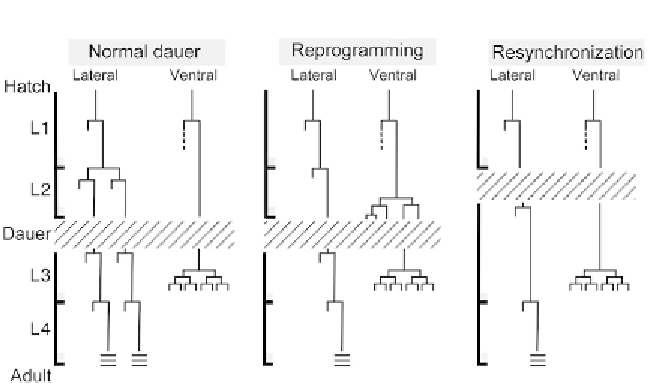Biology Reference
In-Depth Information
Figure 6.4 Schematic of cell lineage behaviors following dauer development. Examples
of lateral and ventral epidermal lineages are shown for wild-type animals and
heterochronic mutants that undergo reprogramming or resynchronization. Lineage dia-
grams are as in
Fig. 6.1
, with the variable amount of time spent in dauer arrest indicated
by hatching. The vulva arises from a subset of the ventral epidermal cells, the vulva pre-
cursor cells (VPCs). Vulval reprogramming occurs in precocious mutants where VPCs
have divided prior to dauer entry; three VPC progeny (only one is shown for simplicity)
will be reprogrammed to divide postdauer, producing the wild-type vulva pattern. Ani-
mals that enter dauer too early, at the L1 molt (third panel), undergo a lengthened larval
stage upon dauer recovery and tissues resynchronize.
pass through dauer, regardless of how many cells were generated prior to
dauer arrest, vulva development is reinitiated, and only three cells divide fur-
ther to generate a proper vulva. Passage through the dauer stage reprograms
the cells so that they revert to their ancestral fates. The only exception is if a
VPC divided three times prior to dauer arrest; such cells are incapable of
being reprogrammed.
The mechanistic explanation for this reprogramming is incomplete;
however, it is known that the expression of certain vulva fate markers and
signaling pathways is repressed during the dauer stage, indicating that any
commitment prior to arrest is therefore reversible (
Karp & Greenwald,
2013
). In addition, the important developmental regulator DAF-16/FOXO
has a critical role in the VPCs themselves for the maintenance of multi-
potency (
Karp & Greenwald, 2013
).
One further variation on this phenomenon is that if certain mutants enter
the dauer stage at the wrong time, then they can still emerge from dauer with

